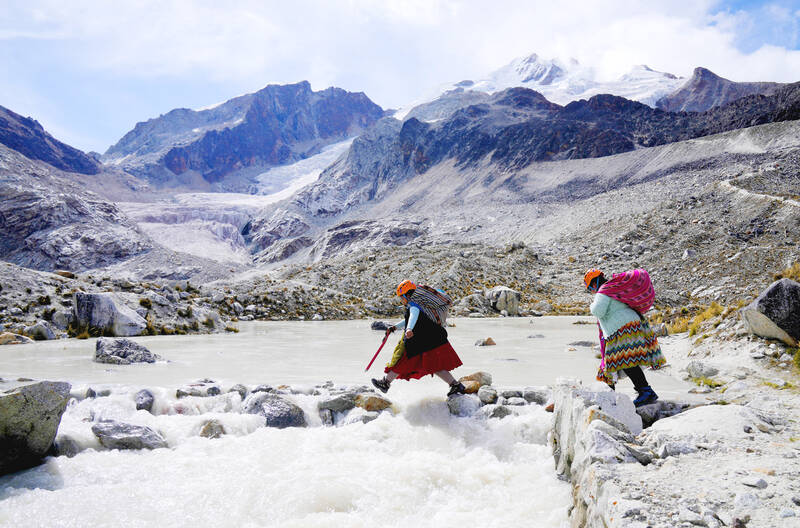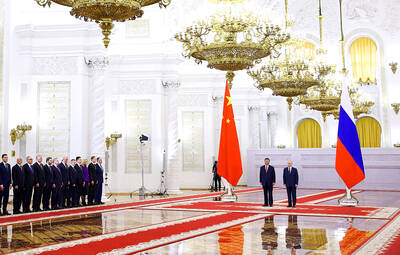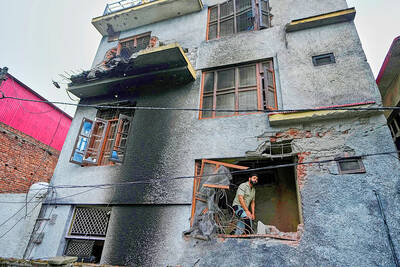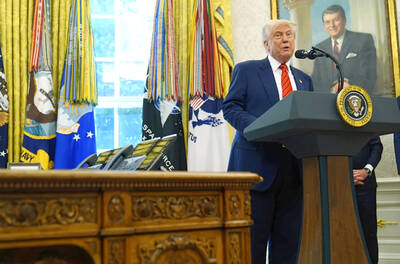When they first started climbing the Andes peaks, they could hear the ice crunching under their crampons. These days, it is the sound of melted water running beneath their feet that they mostly listen to as they make their ascents.
Dressed in colorful, multilayered skirts, a group of 20 indigenous Bolivian women — known as the Cholita climbers — have been climbing the mountain range for the past eight years, working as tourist guides.
As the glaciers in the South American country retreat as a result of climate change, they worry about the future of their jobs.

Photo: AP
The Aymara women remember a time when practically every spot on the glaciers was covered in snow. Now there are parts with nothing but rocks.
“There used to be a white blanket and now there is only rock,” said Lidia Huayllas, one of the climbers. “The thaw is very noticeable.”
Huayllas said she has seen the snowcapped Huayna Potosi mountain, a 6,000m peak near the Bolivian city of El Alto, shrink little by little in the past two decades.
“We used to walk normally. Now, there are rocks and water overflowing,” the 57-year-old woman said, as she jumped from stone to stone to avoid getting her skirt and feet wet.
Edson Ramirez, a glaciologist from Pierre and Marie Curie University in France, said that in the past 30 years, Bolivian glaciers have lost 40 percent of their thickness due to climate change.
In the lower parts of the mountain, the ice has basically vanished, Ramirez said.
“We already lost Chacaltaya,” he said, referring to a 5,400m mountain that used to be a popular ski resort, but now has no ice left.
With no ice on the lower parts of the mountain range, the Cholita climbers need to travel further up to find it. This has reduced the number of tourists seeking their services as guides.
Huayllas would not say how much she makes as a tour guide, but she said a Cholita climber makes about US$30 per tour. That is less than the US$50 per tour they used to make.
During last year’s September-to-December climbing season, the Cholitas did 30 tours, Huayllas said.
This year, through early last month, they had barely done 16, she said.
The situation has gotten so critical, the 20 women have looked for other jobs to make ends meet. Some of the Cholitas have started making and selling blankets and coats with alpaca wool from the Andes, Huayllas said.
“If this continues, we’re going to have to work in commerce or do something else for a living,” she said.
However, she quickly dismissed her own pessimistic thought, somehow hoping for a change.
“No. This is our source of work,” she said.

A new online voting system aimed at boosting turnout among the Philippines’ millions of overseas workers ahead of Monday’s mid-term elections has been marked by confusion and fears of disenfranchisement. Thousands of overseas Filipino workers have already cast their ballots in the race dominated by a bitter feud between President Ferdinand Marcos Jr and his impeached vice president, Sara Duterte. While official turnout figures are not yet publicly available, data from the Philippine Commission on Elections (COMELEC) showed that at least 134,000 of the 1.22 million registered overseas voters have signed up for the new online system, which opened on April 13. However,

ALLIES: Calling Putin his ‘old friend,’ Xi said Beijing stood alongside Russia ‘in the face of the international counter-current of unilateralism and hegemonic bullying’ Chinese President Xi Jinping (習近平) yesterday was in Moscow for a state visit ahead of the Kremlin’s grand Victory Day celebrations, as Ukraine accused Russia’s army of launching air strikes just hours into a supposed truce. More than 20 foreign leaders were in Russia to attend a vast military parade today marking 80 years since the defeat of Nazi Germany in World War II, taking place three years into Russia’s offensive in Ukraine. Putin ordered troops into Ukraine in February 2022 and has marshaled the memory of Soviet victory against Nazi Germany to justify his campaign and rally society behind the offensive,

CONFLICTING REPORTS: Beijing said it was ‘not familiar with the matter’ when asked if Chinese jets were used in the conflict, after Pakistan’s foreign minister said they were The Pakistan Army yesterday said it shot down 25 Indian drones, a day after the worst violence between the nuclear-armed rivals in two decades. Pakistani Prime Minister Shehbaz Sharif vowed to retaliate after India launched deadly missile strikes on Wednesday morning, escalating days of gunfire along their border. At least 45 deaths were reported from both sides following Wednesday’s violence, including children. Pakistan’s military said in a statement yesterday that it had “so far shot down 25 Israeli-made Harop drones” at multiple location across the country. “Last night, India showed another act of aggression by sending drones to multiple locations,” Pakistan military spokesman Ahmed

US President Donald Trump on Wednesday said that he would make a decision about how the US government would refer to the body of water commonly known as the Persian Gulf when he visits Arab states next week. Trump told reporters at the White House that he expects his hosts in Saudi Arabia, Qatar and the United Arab Emirates will ask him about the US officially calling the waterway the Arabian Gulf or Gulf of Arabia. “They’re going to ask me about that when I get there, and I’ll have to make a decision,” Trump said. “I don’t want to hurt anybody’s